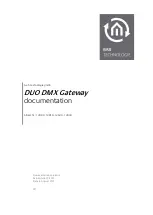
Noise enhancement
DN530
Operator Manual
31
Noise enhancement
We all have the ability to block out constant background noises and often using a gate
to eliminate background noises altogether defeats this mechanism. This tends to draw
our attention to the noise when the gate opens. Typically, adjusting the gate range
down to 10dB or 15dB produces results that sound much more natural.
Ducking
Ducking is used to automatically reduce the signal levels when the level of a source
signal (from the external sidechain) goes over threshold. This is typically used in
situations requiring a voice-over. For example, when an announcer or DJ wants to
speak, the background music is automatically made to
duck
(is attenuated) so that
their voice can be heard clearly and at a normal level.
De-essing
Compressors have traditionally been used for de-essing, but the degree of de-essing
achieved is very level dependent, that is, the loud passages will have sibilance ("s"
sounds) attenuated more than the quiet ones.
De-essing using the duck mode of the DN530 is an alternative way of removing
sibilance, rather than using compression. Use the solo to tune the sidechain filter into
the sibilance (around 10kHz). Set the attack relatively fast (1ms), and similarly with
the release (30ms), plus a little hold and then trim the threshold so that the gate meter
respond to all the sibilant sounds but not to normal speech. Attenuation ranges that
are between 6dB to 10dB will produce the best results, consistently reducing sibilance
to the same degree.
Summary of Contents for DN530
Page 2: ......
Page 6: ......
Page 10: ...Precautions DN530 x Operator Manual...
Page 16: ...Chapter 1 Introduction DN530 4 Operator Manual...
Page 20: ...Chapter 2 What Is A Gate DN530 8 Operator Manual...
Page 44: ...Application Notes DN530 32 Operator Manual...
Page 50: ...Balanced Unbalanced Audio DN530 38 Operator Manual...














































